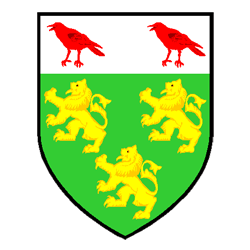The Wearing of the Green
During the penal law era, under British rule, one of the many atrocities against Irish Catholics was colonization. This meant the confiscation of land to be handed over to British Gentry. The Irish were then forced to pay rent for land that had previously been their property. During this period, over 500,000 families were evicted from their homes. During and following this period, many famous Irish rebels made their mark in Irish history, including Fr. John Murphy, Wolfe Tone, Patrick Pearse, and the bold Robert Emmet. Robert Emmet was executed for participating in the uprising of 1803. He gave a dramatic speech before his death, ” when my country takes her place among the nations of the earth, then, and not till then, let my epitaph be written.”
In opposition to British rule, the bitterness and discontent began organize, and in 1791 the Irish formed a political group called the “United Irishmen.” The emblem or symbol of the United Irishmen was the green banner with the harp on it. After attempts by the British Government to extinguish the United Irishmen a series of small battles broke out in the countryside. In 1798, the rebel United Irishmen stood their final ground at the battle of Vinegar Hill, near Enniscorthy. The Irish were greatly outnumbered and thousands died during this battle under the green banner. From this time forward the “green” has been a symbol of Irish unity and identity.
The resentment towards British rule carried heavily over into the United States, when millions of Irish were forced to leave their homeland during the famine years. The “green” came with them and was symbolic of the Irish struggle for independence, which most of Ireland received in 1922. In Ireland St. Patrick’s Day is usually celebrated as a religious day and a “spricket” of shamrock is pinned to one’s jacket.
In the U.S, the first St. Paddy’s Day parade took place in 1779. The parades have since then, along with the wearin O’ the green, become a symbol of Irish Unity and cultural identity. The following song was once the national anthem of Ireland and can still be heard being sung on St. Patrick’s day by Irish Americans.
O Paddy dear, an did ye hear the news that’s goin’ round?
The shamrock is by law forbid to grow on Irish ground!No more St. Patrick’s Day we’ll keep, his color can’t be seen,
For there’s a cruel law agin the wearin’ O’ the green!I met with Napper Tandy, and he took me by the hand,
and he said, “how’s poor old Ireland, and how does she stand?”She’s the most distressful country that ever yet was seen,
for they’re hangin’ men and women there, for wearin’ O’ the green.So if the color we must wear be England’s cruel red,
let it remind us of the blood that Irishmen have shed;and pull the shamrock from your hat, and throw it on the sod,
but never fear, twill take root there, though underfoot when trod.When law can stop the blades of grass from growin’ as they grow,
and when leaves in summer-time their color dare not show,then I will change the color too I wear in my caubeen (plush hat).
But till that day, please God, I’ll stick to the wearin’ O’ the Green.
La le Padraig, or St. Patrick’s Day, is, according to tradition, the date on which Patrick died in Ulster (March 17, 461 A.D.). The precise date of Patrick’s death is not known to scholars. It is known that he was born the son of an aristocrat in an unknown part of Britain, around the year 385 A.D. His original birthplace is a heavily debated topic by modern scholars. Patrick’s full name was Magonus Sucatus Patricius. Patrick first came to Ireland at the age of sixteen when Irish raiders took him into captivity. He spent six years in Ireland as a slave, tending sheep in the mountains. During his captivity, Patrick kept hearing a voice in his dreams urging him to return home. He then escaped and walked 200 miles to a boat on the shore which the voice in his dream said would be waiting for him.
Upon returning home to his relatives Patrick pursued ecclesiastical training, which scholars believe he did in Gaul. During his training, Patrick states that he heard the voice of the Irish calling him back. In Patrick’s own vivid account of these dreams calling him back, he states a voice called out loud, “we ask thee, boy, come and walk among us once more.” Eventually, a bishop was appointed to Ireland, for which Patrick was not chosen and he was greatly disappointed.
In 432 A.D., against great opposition by church leaders, Patrick was appointed bishop of Ireland and returned to the Irish. During Patrick’s mission in Ireland, he encountered great resistance from the old druidic tradition and ruling class. He continually challenged the pagan chieftains and in doing so lived in daily danger of murder, treachery or captivity. Patrick was reputed to be fearless in confrontation with his enemies. He traveled to remote corners of Ireland to convert pagans to Christianity, baptized thousands, ordained many new clerics and started thriving new monasteries. St. Patrick demonstrated the concept of the Trinity to his converts through the comparison of the shamrock, with its three leaves yet one individual plant, to the Father, Son and Holy Spirit as one also. In a span of thirty years Patrick had converted almost all of Ireland to Christianity.
It is believed that Patrick was buried in a grave in the cathedral cemetery of Downpatrick. However, evidence for this is shaky since the tomb has been disturbed by looters on numerous occasions and any remains are now gone.
— Patrick Dutter
